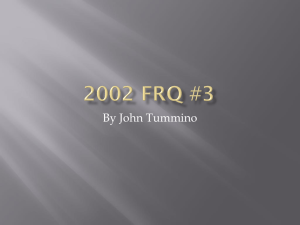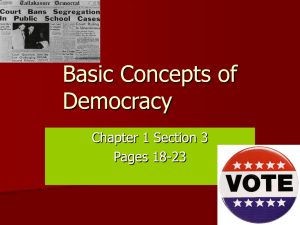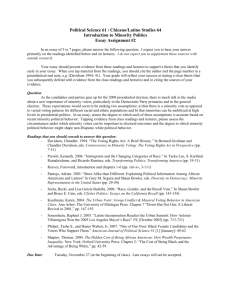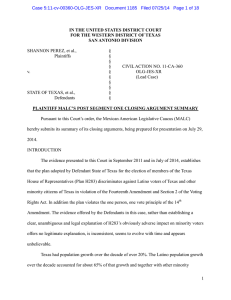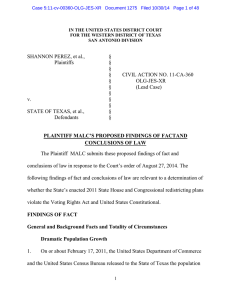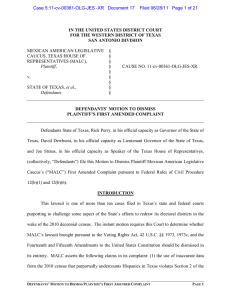SHANNON PEREZ, et al., § Plaintiffs
advertisement
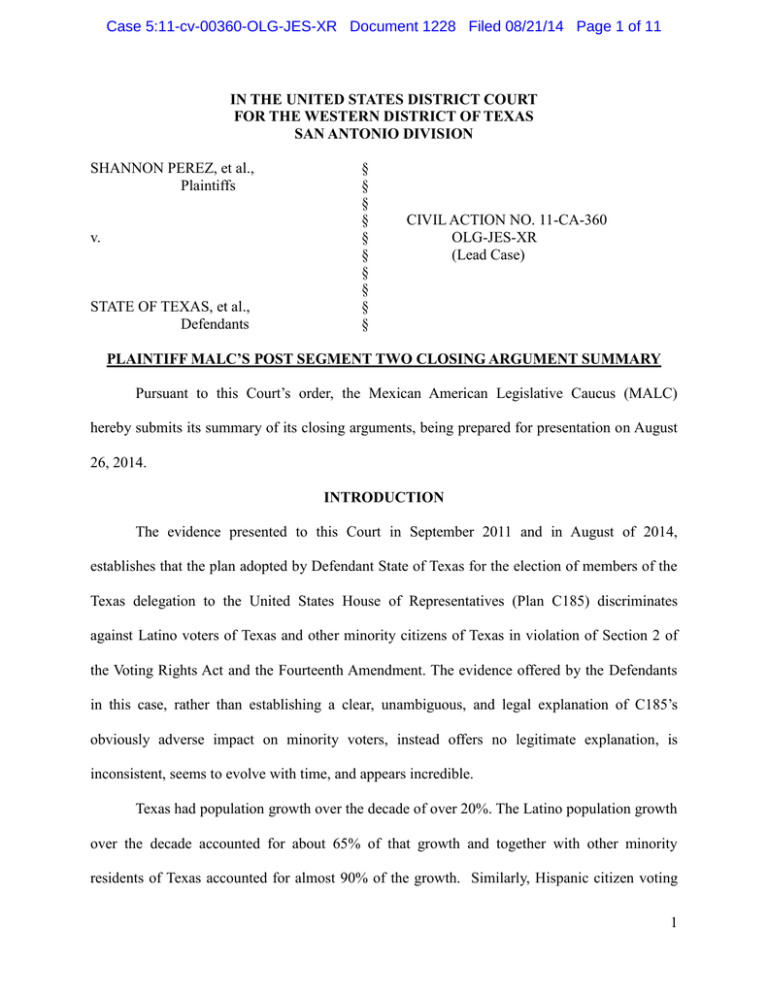
Case 5:11-cv-00360-OLG-JES-XR Document 1228 Filed 08/21/14 Page 1 of 11 IN THE UNITED STATES DISTRICT COURT FOR THE WESTERN DISTRICT OF TEXAS SAN ANTONIO DIVISION SHANNON PEREZ, et al., Plaintiffs v. STATE OF TEXAS, et al., Defendants § § § § § § § § § § CIVIL ACTION NO. 11-CA-360 OLG-JES-XR (Lead Case) PLAINTIFF MALC’S POST SEGMENT TWO CLOSING ARGUMENT SUMMARY Pursuant to this Court’s order, the Mexican American Legislative Caucus (MALC) hereby submits its summary of its closing arguments, being prepared for presentation on August 26, 2014. INTRODUCTION The evidence presented to this Court in September 2011 and in August of 2014, establishes that the plan adopted by Defendant State of Texas for the election of members of the Texas delegation to the United States House of Representatives (Plan C185) discriminates against Latino voters of Texas and other minority citizens of Texas in violation of Section 2 of the Voting Rights Act and the Fourteenth Amendment. The evidence offered by the Defendants in this case, rather than establishing a clear, unambiguous, and legal explanation of C185’s obviously adverse impact on minority voters, instead offers no legitimate explanation, is inconsistent, seems to evolve with time, and appears incredible. Texas had population growth over the decade of over 20%. The Latino population growth over the decade accounted for about 65% of that growth and together with other minority residents of Texas accounted for almost 90% of the growth. Similarly, Hispanic citizen voting 1 Case 5:11-cv-00360-OLG-JES-XR Document 1228 Filed 08/21/14 Page 2 of 11 age population experienced significantly increased growth. Remarkably, the Defendants’ witnesses explained that no efforts were undertaken except as an after-thought,1 to determine whether the dramatic population growth in the Latino and minority populations would permit or require the creation of additional minority districts. (Testimony of Solomons, Seliger, Interiano and Downton). Instead, the Congressional redistricting plan adopted by the State actually reduced the proportion of minority and Latino opportunity districts when compared with the benchmark. (10 of 32 or 31% in C100, compared to 10 of 36 or 27.8% in C 185). Experts for the United States (Arrington and Handley), for MALC (Kousser), and other plaintiffs determined that C185 reduced the proportion of minority opportunity districts from the benchmark; carved up minority voters to insure submergence in Anglo dominated districts (north Texas and Nueces County); and, manipulated turn-out data to reduce Latino voter effectiveness (CD 23). The Defendants’ witnesses admitted that they used the Texas Attorney General’s racially polarized voting analysis (rpv), as a barometer to measure success of Latino-preferred candidates as they drew districts. Thus in CD 23, the State’s map drawers took a marginal opportunity district and increased HCVAP, while manipulating district lines in such a fashion to reduce the actual performance of Latino-preferred candidates. In Tarrant County, the map drawer, Mr. Downton, harvested Latino voters from the center of Fort Worth, in a jagged and twisted search for Latino voters in order to place them in an Anglo dominated, suburban CD 26, which purposely separated Fort Worth African American voters from Latino voters, into an Anglo dominated CD 12. 1 Defendants map drawer Mr. Downton, admitted that a variety of diverse groups supported a district in Dallas and Tarrant Counties that sought to provide electoral opportunities for Latino voters but he followed Chairman Seliger’s directive that no such district would be drawn unless it was a majority cvap of one protected minority group. Chairman Seliger testified that they supported the drawing of a district that provided Latino voters an opportunity to elect a candidate of choice, but was advised by Mr. Downton, that only if such a district reached majority of cvap of a single protected minority could such a district be drawn. No other efforts were made to determine the possibility for such districts. 2 Case 5:11-cv-00360-OLG-JES-XR Document 1228 Filed 08/21/14 Page 3 of 11 These facts, as dramatic as they are, are only the beginning. While the Court should begin here in its analysis of Plaintiffs claims, those facts are by no means the totality of the inquiry. FOURTEENTH AMENDMENT “INTENT TO DISCRIMINATE” Admittedly, determining legislative intent is not for the weak of heart. Some believe wrongly that this requires an excavation into the emotional lives of state legislators. For instance, the State has routinely asked whether or not minority state legislators believe that Chairman Seliger, Solomons is a good man or whether or not a minority legislator can name another legislator they believe is a racist. This parlor game is dispositive of nothing. Determining legislative intent is the unique province of this court. The federal judiciary has been determining legislative intent since Marbury v. Madison. It is not a metaphysical séance with a crystal ball. It is a fact-based investigation performed by this court. Arlington Heights offers a rubric by which courts may determine legislative intent in violation of the 14th Amendment. A review of the facts here, consistent with the Arlington Heights factors leads to the conclusion that the adverse impact of the redistricting actions of the State were intentional. Impact of the Challenged Decision The impact of the state congressional map on the minority community is undisputed. The benchmark plan, C100, contained 7 Latino opportunity districts out of 32 districts or 21.8%. C185 also contains 7 Latino opportunity districts, but out of 36 districts or 19.4%. 2 This reduction in the proportion of ability to elect seats came while the Latino population fueled 65% of the population growth in the inter-censual period.3 There is simply no way this is some kind of 2 Kousser testimony, Arrington testimony. Texas often cities the difference between Citizen Voting Age Population Growth and Total Population. Even if this mattered, CVAP population among the minority population in Texas far outpaced the Anglo CVAP in the same time period. “In a state where during the preceding decade the Latino citizen voting age population was more than 3 3 Case 5:11-cv-00360-OLG-JES-XR Document 1228 Filed 08/21/14 Page 4 of 11 accident. The only way the minority community would lose their proportion of seats is if a purposeful series of decisions were made to the detriment of the minority community. And, that is exactly what happened. Historical Background of Decisions Texas has a long, racist history no matter who has been in control of elections. Legislative intent is in redistricting is principally about the policy decisions that were made. A few spare decisions going against the minority community could be explained as unlucky. Even several made over the course of six months could be explained. But, when nearly every critical decision made in the congressional map that affected minorities was decided in a way that diluted their votes, a pattern of intent has been established. It is MALC’s belief that the evidence shows that when the State had discretion to make a policy choice that would help or harm the ability of minorities to elect candidates of their choice, the state chose the latter. Precinct Splits Generally, the evidence has shown that the state used precinct splits in urban areas to harvest Latino and minority voters for placement in Anglo dominated suburban districts (CD 26, CD 12, CD 6, and CD 33) and to reduce the Latino voting performance in competitive CD 23. The disproportionate concentration of split precincts in minority areas makes clear that the linedrawers accomplished their task with considerable precision.”4 Specifically, these precinct splits were used to divide neighborhoods along racial lines in order to dilute the strength of the minority vote. This claim is also nothing new, as MALC has often highlighted the split precinct issue used in the development of the Texas House plan, as to 700,000 compared to the Anglo growth in citizen voting age population of only 487,000, Texas managed to artfully craft the lines for its State House plan to create a net decrease in the number of districts in which Latinos could elect their candidate of choice.” 2014 TT. at 67:8-14. 4 2014 TT of Dr. Arrington, and Dr. Flores, and Downton. 4 Case 5:11-cv-00360-OLG-JES-XR Document 1228 Filed 08/21/14 Page 5 of 11 HDs 26, 41, 78 and 105 in several of our previous filings in this court. However, during this phase of the trial, the micro-detail explaining the harm to the minority community of the precinct splits in Tarrant and Dallas Counties and in CD 23 was compelling. SECTION 2 OF THE VOTING RIGHTS ACT The Supreme Court first construed the amended version of § 2 of the Voting Rights Act, 42 U.S.C. § 1973, in Thornburg v. Gingles, 478 U.S. 30, (1986). In Gingles, the plaintiffs were African-American residents of North Carolina who alleged that multimember districts diluted minority voting strength by submerging black voters into the white majority, denying them an opportunity to elect a candidate of their choice. The Court identified three "necessary preconditions" for a claim that the use of multimember districts constituted actionable vote dilution under § 2: (1) The minority group must be "sufficiently large and geographically compact to constitute a majority in a single-member district," (2) the minority group must be "politically cohesive," and (3) the majority must vote "sufficiently as a bloc to enable it . . . usually to defeat the minority's preferred candidate." Id. at 50-51. The first of the Gingles preconditions is commonly referred to as Gingles I. 1. Gingles I In the Fifth Circuit, a bright-line test for meeting the Gingles I precondition requires the presentation of district(s) in which the minority group is at least 50% of the citizen voting age population. Valdespino v. Alamo Heights I.S.D., 168 F.3d 848 (5th Cir. 1999) cert. denied, 528 U.S. 1114 (2000). 2. Gingles II and III Whether the minority group demonstrates it is politically cohesive embodies a functional focus. "If the minority group is not politically cohesive, it cannot be said that the selection of a 5 Case 5:11-cv-00360-OLG-JES-XR Document 1228 Filed 08/21/14 Page 6 of 11 multimember electoral structure thwarts distinctive minority group interests." Gingles, 478 U.S. at 51. In Gomez v. City of Watsonville, 863 F.2d 1407, 1415 (9th Cir. 1988), cert. denied, 489 U.S. 1080, 103 L. Ed. 2d 839, 109 S. Ct. 1534 (1989), the Ninth Circuit observed, "the inquiry is essentially whether the minority group has expressed clear political preferences that are distinct from those of the majority." Thus, political cohesiveness is determined by looking at the "voting preferences expressed in actual elections." Id. Necessarily, when we examine the evidence of political cohesiveness as voting preferences, we look to the same statistical evidence plaintiffs must offer to establish vote polarization. Indeed, political cohesiveness is implicit in racially polarized voting.5 Gingles adopted a straightforward definition of racial bloc voting provided by the expert witness upon whom the district court had relied. Racial polarization or bloc voting "exists where there is a consistent relationship between the race of the voter and the way in which the voter votes ... or to put it differently, where black voters and white voters vote differently." 478 U.S. at 53, n.21 (internal quotation marks omitted). While these three pre-conditions are necessary to establish a vote dilution claim, they alone are not sufficient. Johnson v. De Grandy, 512 U.S. 997, 129 L. Ed. 2d 775, 114 S. Ct. 2647, 2657 (1994). The Court in De Grandy, determined that a court's examination of relevant circumstances is not complete "once the three factors were found to exist, or in the sense that the three in combination necessarily and in all circumstances demonstrated dilution." Id. This is so "because the ultimate conclusions about equality or inequality of opportunity were intended by Congress to be judgments resting on comprehensive, not limited, canvassing of relevant facts." Id. Failure 5 Gingles stated that one purpose of determining the existence of racially polarized voting is "to ascertain whether minority group members constitute a politically cohesive unit ...." 478 U.S. at 56. 6 Case 5:11-cv-00360-OLG-JES-XR Document 1228 Filed 08/21/14 Page 7 of 11 to prove the totality of circumstances establishes the minority is not harmed by the challenged practice and rebuts the inference of discrimination arising from proof of the three preconditions. Uno v. City of Holyoke, 72 F.3d 973, 980 (1st Cir. 1995). In a review of the totality of circumstances the court should be guided by the factors identified by Congress commonly referred to as the Senate factors. The Senate Report accompanying the 1982 amendments elaborates on the proof for a § 2 analysis, specifying a "variety of relevant factors, depending upon the kind of rule, practice, or procedure called into question." S. Rep. No. 417, 97th Cong., 2d Sess. 28-29 (1982), reprinted in 1982 U.S.C.C.A.N. 177, 206-07. The Senate Report added that "there is no requirement that any particular number of factors be proved, or that a majority of them point one way or the other." Id. at 207. Most importantly, "the question whether the political processes are 'equally open' depends upon a searching practical evaluation of the 'past and present reality,' and on a 'functional' view of the political process." Id. (quoting S. Rep. No. 417, 1982 U.S.C.C.A.N. 177, 208). The lack of electoral opportunity is the key. Section 2 Factual Record 1. Gingles I With regard to the ability to develop redistricting plans for the Texas congressional delegation with more Latino and minority opportunity districts than were created in the new Plan C 185, the record is not seriously disputed. In the initial trial of this matter, Plaintiff MALC presented plans that showed alternative plans with more: Hispanic Voting Age Population (HVAP) majority districts than C185, and more Citizen Voting Age Population (HCVAP) majority districts than C185.6 In the subsequent trial of this matter Plaintiff LULAC presented an additional plan with 6 Joint Map Exhibits, Exhibit C163, C164, C165, and C188. 7 Case 5:11-cv-00360-OLG-JES-XR Document 1228 Filed 08/21/14 Page 8 of 11 more HCVAP districts than C 185. LULAC exhibit 11, Plan C 262. Clearly, Plaintiff MALC met the requirements of Gingles I. 2. Gingles II and III In 2011 Plaintiff MALC presented evidence of racial polarized voting using the traditional statistical methods approved by the United States Supreme Court in Gingles.7 Dr. Kousser, Plaintiff MALC’s expert reviewed a number of state-wide and local elections employing ecological regression statistical methodologies in three different ways: least squares, weighted least squares and ecological inference or King’s EI. 8 Dr. Koussers’ conclusion was that the data was driving the result, so regardless of the method employed the same results were achieved – elections in Texas continue to be polarized, Latinos are politically cohesive and Anglos vote sufficiently as a bloc to defeat the Latino preferred candidate in Texas General Elections.9 Moreover, Latinos and African American voters vote together and are politically cohesive in the General Elections in Texas. 10 All of the other Plaintiffs’ experts on polarized voting came to the same conclusions as the results of their statistical analyses were remarkably similar. In the 2014 trial of this cause Plaintiff MALC submitted the testimony and analysis of Dr. Robert Brischetto. Dr. Brischetto reviewed the expert reports of Dr. Kousser and others and updated MALC’s analysis with a polarized voting study of 2012 elections in regions of focus for MALC’s claims. 11 Specifically, Dr. Brischetto focused on elections in Midland, Ector, Lubbock, Nueces, Kleberg, Bell, and Fort Bend Counties. His findings were remarkable. Latinos voted cohesively in primary and general elections in Midland/Ector, Lubbock, Nueces, and Kleberg 7 MALC’s Exhibit 19, pp. 7-53. MALC’s Exhibit 19, pp. 26-53 ; 2011TT. pp. 214-217. 9 2011TT. pp. 217, 229, 249-250; Plaintiff MALC’s Exhibit 19, pp. 26-52. 10 2011 TT. pp. 229; Plaintiff MALC’s Exhibit 19, pp. 51-52. 11 MALC Exhibits 161, 163-166. 8 8 Case 5:11-cv-00360-OLG-JES-XR Document 1228 Filed 08/21/14 Page 9 of 11 Counties, Latinos and other minorities voted cohesively in general elections in Bell and Fort Bend Counties. In addition, elections were polarized so that non-Latinos voted cohesively against Latino-preferred candidates in both primary and general elections in Midland, Ector, Lubbock, Nueces and Kleberg Counties and non-minority voters voted cohesively against minority-preferred candidates in general elections in Fort Bend and Bell Counties. Dr. Brischetto’s findings were consistent with the conclusions reached by Dr. Kousser in 2011. Moreover, Dr. Brischetto’s determination that elections were polarized in primary elections as well as in general elections is evidence that partisan voting does not justify or explain the racial voting differences. Finally, while counsel for the State conceded racial polarized voting in Midland, Ector, Lubbock, Bell, and Fort Bend Counties, the argument against racial polarized voting is Kleberg and Nueces County amounts to sophistry. Plaintiff MALC’s evidence on Gingles II and III is compelling and not seriously challenged. 3. Totality of Circumstances Substantial evidence of the totality of circumstances issues was presented at the initial trial. More recently, MALC updated the continuing effects of discrimination through Mr. Korbel. Not only are Latinos and minorities continuing to lag significantly behind their Anglo counter parts, throughout the State, Mr. Korbel’s review of the data shows that in the focus regions those disparities are equal to or worse to the State-wide numbers. In addition, Plaintiff MALC presented the testimony of Commissioner Sanchez of Midland County and Commissioner Sedeño of Lubbock County. Both gave compelling testimony regarding the cohesion of the Latino community in their respective counties. In addition, other Plaintiffs in this cause submitted evidence relevant to the totality of 9 Case 5:11-cv-00360-OLG-JES-XR Document 1228 Filed 08/21/14 Page 10 of 11 circumstances inquiry supporting a section 2 violation. The record on totality of circumstances is not only unchallenged, but no alternative evidence was submitted by the Defendants at all. The record in this case establishes Plaintiff’s Section 2 claim and this Court should enter Judgment for Plaintiff. CONCLUSION On the record of this case, the MALC is entitled to Judgment on all of the claims presented in this case. Plaintiff MALC has presented evidence establishing that Texas Congressional plan C 185 violates Section 2 of the Voting Rights Act, 42 U.S.C. §1973 both as to effect and intent; and that the challenged plan was adopted with the intent to discriminate against and disadvantage Latino voters in violation of the 14th Amendment of the United States Constitution. Plaintiff MALC should be granted Judgment in this case. DATED: August 21, 2014 Respectfully submitted, _____/s/ Jose Garza_________________ JOSE GARZA Texas Bar No. 07731950 Law Office of Jose Garza 7414 Robin Rest Dr. San Antonio, Texas 78209 (210) 392-2856 garzpalm@aol.com JOAQUIN G. AVILA LAW OFFICE P.O. Box 33687 Seattle, Washington 98133 Texas State Bar # 01456150 (206) 724-3731 (206) 398-4261 (fax) jgavotingrights@gmail.com 10 Case 5:11-cv-00360-OLG-JES-XR Document 1228 Filed 08/21/14 Page 11 of 11 Ricardo G. Cedillo State Bar No. 04043600 Mark W. Kiehne State Bar No. 24032627 DAVIS, CEDILLO & MENDOZA, INC. McCombs Plaza, Suite 500 755 E. Mulberry Avenue San Antonio, Texas 78212 Tel.: (210) 822-6666 Fax: (210) 822-1151 rcedillo@lawdcm.com mkiehne@lawdcm.com ATTORNEYS FOR MEXICAN AMERICAN LEGISLATIVE CAUCUS, TEXAS HOUSE OF REP. (MALC) CAUSE NO. 5:11-CV-361-OLG-JES-XR CERTIFICATE OF SERVICE I hereby certify that a true and correct copy of the foregoing document has been sent by the Court’s electronic notification system August 21, 2014, to counsel of record registered with the court to receive same and to those not so registered the foregoing document has been sent by email as agreed by the parties for each of the cases referenced above, . ___/s/ Jose Garza_______________ Jose Garza 11
